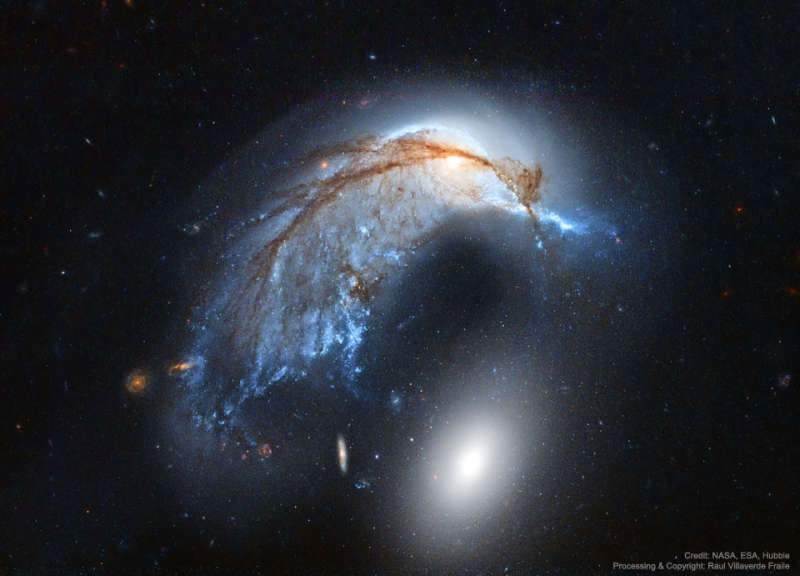Credit & Copyright: Raul Villaverde
Explanation:
What's happening to this spiral galaxy?
Just a few hundred million years ago,
NGC 2936, the upper of the two large
galaxies shown, was likely a
normal spiral galaxy --
spinning, creating stars -- and minding its own business.
But then it got too close to the
massive elliptical galaxy
NGC 2937 below and took a dive.
Dubbed the
Porpoise Galaxy for its iconic
shape, NGC 2936 is not only being deflected but also being distorted by the
close gravitational interaction.
A burst of young blue stars forms the nose of the porpoise toward the right of the
upper galaxy, while the center of the spiral appears as an eye.
Alternatively, the galaxy pair, together known as
Arp 142, look to some like a
penguin protecting an egg.
Either way, intricate dark dust lanes and bright blue star streams trail the troubled
galaxy to the lower right.
The featured re-processed image showing
Arp 142 in unprecedented detail was taken by the Hubble Space
Telescope last year.
Arp 142 lies about 300
million light years away toward the constellation, coincidently, of the Water Snake
(Hydra).
In a billion years or so the two galaxies will likely merge into one larger galaxy.
Almost Hyperspace:
Random APOD Generator
1999 2000 2001 2002 2003 2004 2005 2006 2007 2008 2009 2010 2011 2012 2013 2014 2015 2016 2017 2018 2019 2020 2021 2022 2023 2024 2025 |
Yanvar' Fevral' Mart Aprel' Mai Iyun' Iyul' Avgust Sentyabr' Oktyabr' Noyabr' Dekabr' |
NASA Web Site Statements, Warnings, and Disclaimers
NASA Official: Jay Norris. Specific rights apply.
A service of: LHEA at NASA / GSFC
& Michigan Tech. U.
|
Publikacii s klyuchevymi slovami:
colliding galaxies - vzaimodeistvuyushie galaktiki
Publikacii so slovami: colliding galaxies - vzaimodeistvuyushie galaktiki | |
Sm. takzhe:
Vse publikacii na tu zhe temu >> | |
